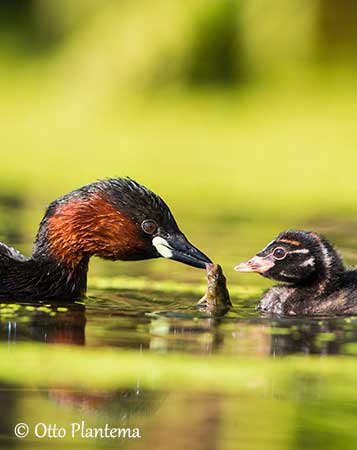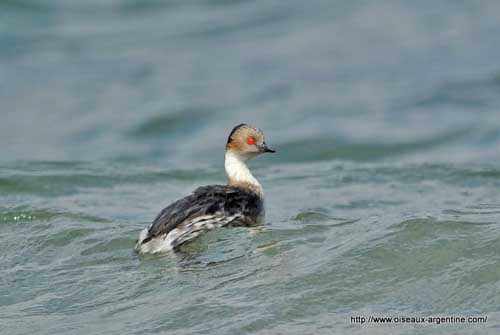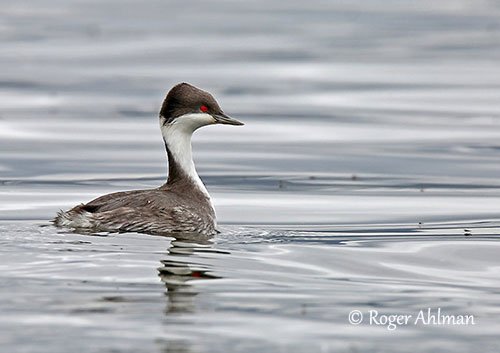
FAMILY PODICIPEDIDAE
PODICIPEDIFORMES ORDER
Grebes
The grebes of the family Podicipedidae in the order Podicipediformes are one of the oldest forms of birds, very present in the fossil register of the New World. They are distributed almost worldwide but they are absent from Arctic, Antarctic, and some oceanic islands.
They do not appear to be closely related to any other group. But the evolutionary history of grebes still remains unclear.
This family includes six genera, with twenty extant species and three extinct.
The genus Podiceps is the most diversified with nine species present in Europe, Asia, North and South America. Most of them migrate and spend the winter along coasts or in warmer climates. However, the Junin Grebe does not fly and is confined to Lake Junín in Peru.
Text and illustration by Nicole Bouglouan
Photographers:
Roger Ahlman
Pbase Galleries Peru and Ecuador
John Anderson
John Anderson Photo Galleries
Didier Buysse
Vision d’Oiseaux
Jean Michel Fenerole
Photos d’Oiseaux du monde
Steve Garvie
RAINBIRDER Photo galleries
Tom Grey
Tom Grey's Bird Pictures & Tom Grey's Bird Pictures 2
Patrick Ingremeau
TAMANDUA
Jean-Claude Jamoulle
A la rencontre des Oiseaux
Eduardo Andrés Jordan
MIS AVES – AVES DE ARGENTINA
Otto Plantema
Trips around the world
Dubi Shapiro
Dubi Shapiro Photo Galleries
Simon Tan
PBase Bird galleries
Ingo Waschkies
Bird Photography
Philippe and Aline Wolfer
OISEAUX D'ARGENTINE
Sources:
HANDBOOK OF THE BIRDS OF THE WORLD vol 1 by Josep del Hoyo-Andrew Elliot-Jordi Sargatal - Lynx Edicions - ISBN: 8487334105
CREAGUS@Monterey Bay (Don Roberson)
Animal Diversity Web (University of Michigan Museum of Zoology)
BIRDS of THE WORLD - An Online Bird Book
Wikipedia, the free encyclopaedia

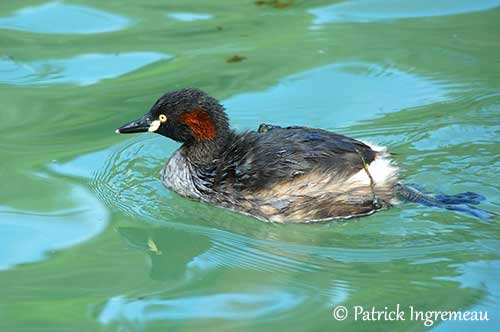
The genus Podilymbus is restricted to America and includes two species, one of which, the Atitlan Grebe, a flightless species, is extinct. Both species are very similar in plumage, but the Atitlan Grebe was much larger.
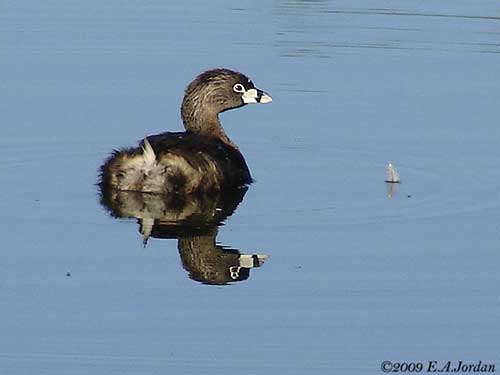
The genus Rollandia contains two species found in South America. One of them, the Titicaca Grebe does not fly and is resident on some Andean lakes.
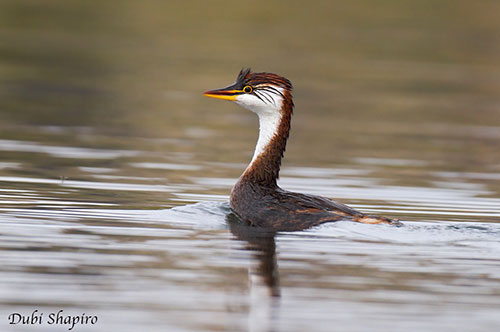
The genus Poliocephalus also includes two small species from Australia and New Zealand.
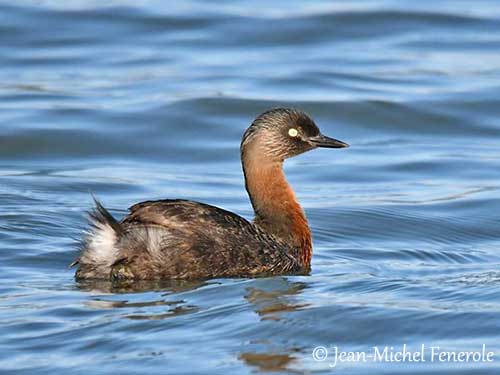
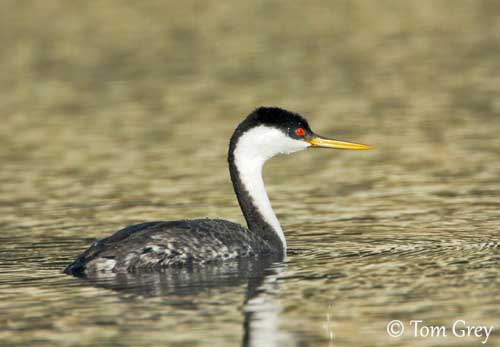
The grebes vary in size, from 23 cm and 128 grams for the Least Grebe of genus Tachybaptus, to 74 cm and 1,600 grams for the Great Grebe of genus Podiceps. Both male and female have fairly similar plumage, but generally, males are slightly larger than females.
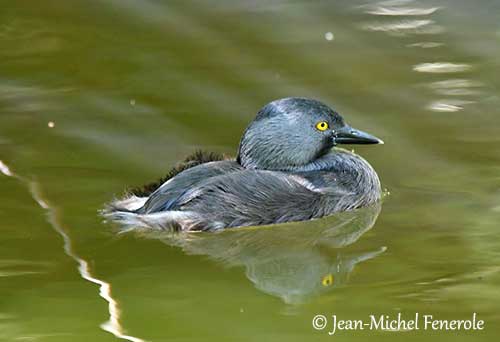
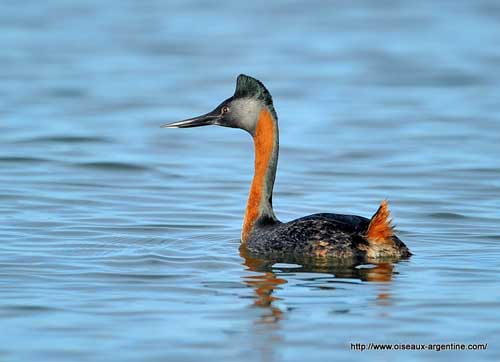
These species are well-adapted to diving and swimming with a streamlined body laterally compressed and rather pointed at the front, making easier to penetrate the water. But on the contrary, the rear is mostly rounded with extremely reduced tail, involving little resistance during the dive. They propel themselves thanks to their strong legs placed far behind the body and the lobed feet. The wings do not help for propulsion and are usually folded during the dive. However, the grebes occasionally use them while swimming among dense vegetation, or to change of direction.
The smallest species dive during about 8-20/10-25 seconds, whereas the larger grebes dive for between 18-26 and 25-30 seconds. The duration of the dive usually gives them enough time to find food, but variations are explained by the depth of the water, the type of prey (invertebrates or fish) and food abundance.
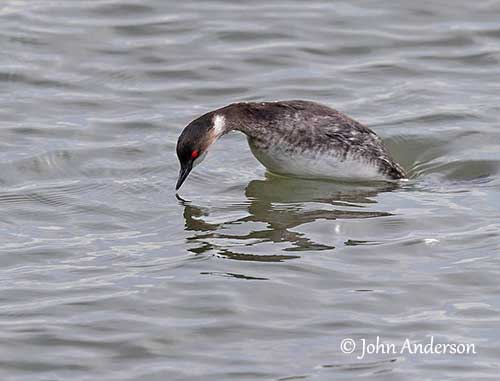
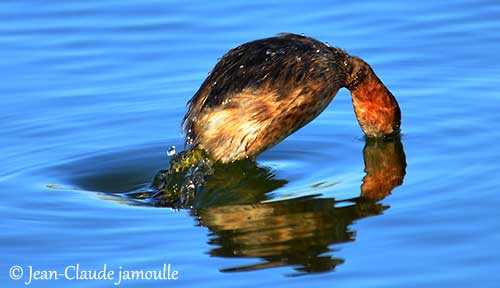
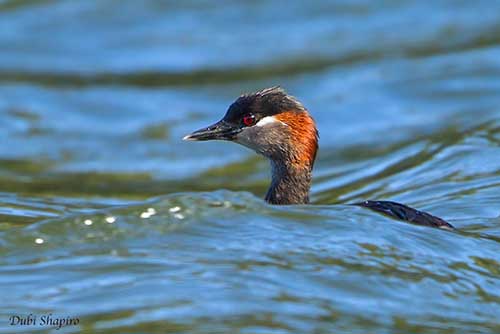
However, the legs positioned well back on the body reduce their ability to walk. For this reason, the nests are floating and built on water, but often close to the shores. When they need to walk, they adopt an erect posture with the body slightly forwards, allowing them to walk and even run over short distances.
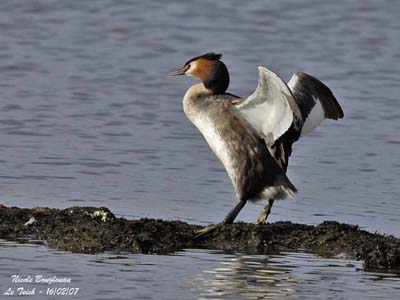
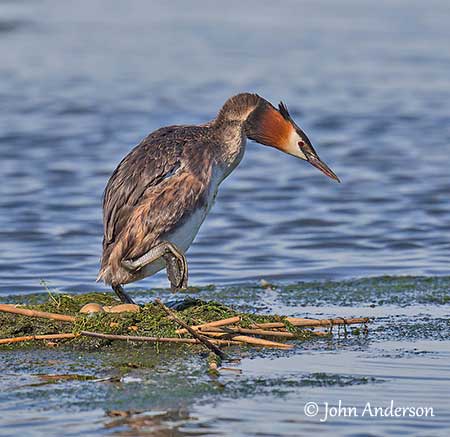
The grebes can fly except the Titicaca Grebe which has a reduced number of primaries, and the Junin Grebe which is unable to take off and maintain level flight. But they need a long running over water surface while beating strongly their wings to help them to take off. Once airborne, the flight is direct with rapid wingbeats. But when threatened, the grebes prefer to dive rather than fly.
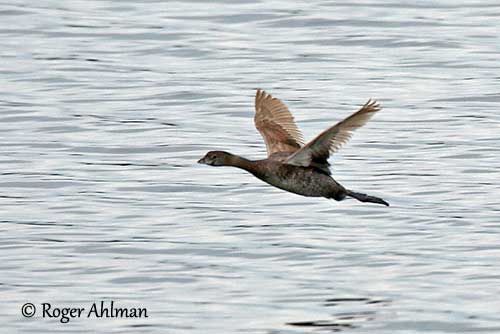
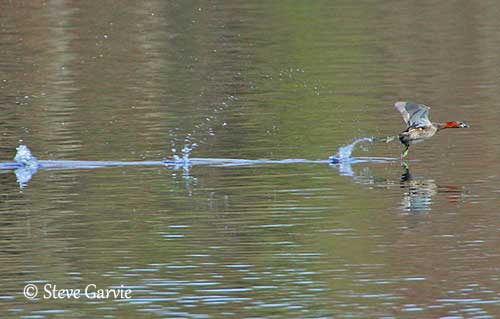
These aquatic birds have extremely waterproof, thick plumage that protects the skin against the permanent humidity. It is loose on the upperparts but downy on rump and tail, and sleeker on the underparts.
Outside the breeding season, the grebes are duller with dark upperparts, often brown or grey, and the underparts are mostly whitish. But in breeding plumage, they show various markings including crests, ruffs, auricular fans, ear-tufts and bright coloured hair-like filaments. Both sexes have these ornaments, but they are brighter in males.
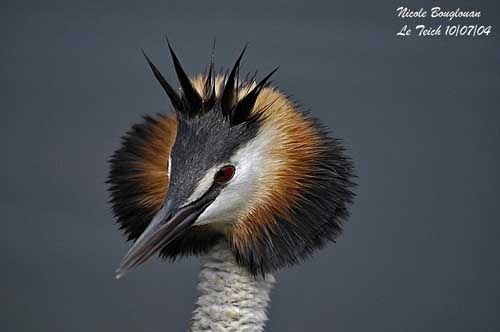
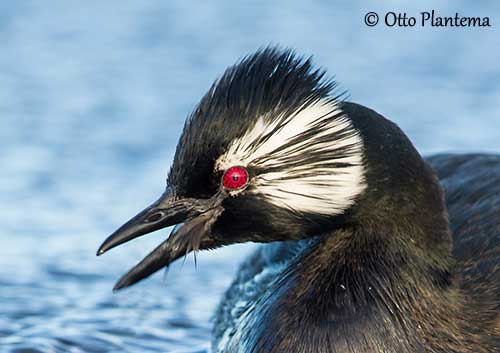
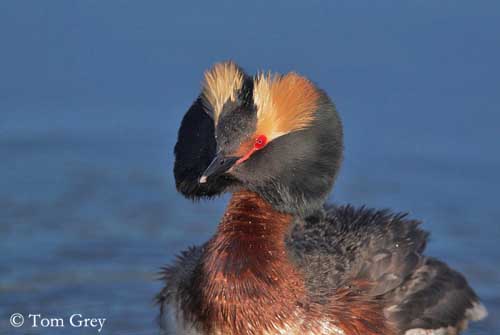
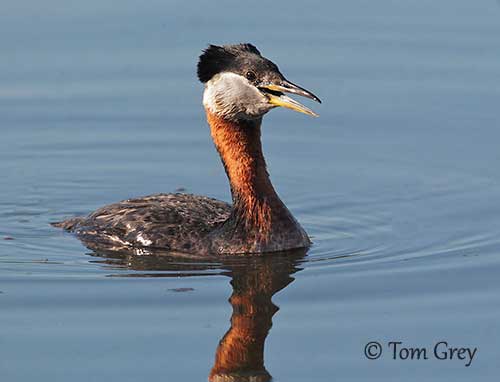
The chicks typically show dark bands, especially on head and neck, except the young birds of genus Aechmophorus which have more uniform appearance. They have a bare patch of skin on the crown. This skin in bright red when the chick is begging for food and it becomes pale yellow when the chick is quiet.
The dark markings are often retained, or at least partially, in the juvenile plumage and in non-breeding adults. They acquire the full adult plumage in the second year.
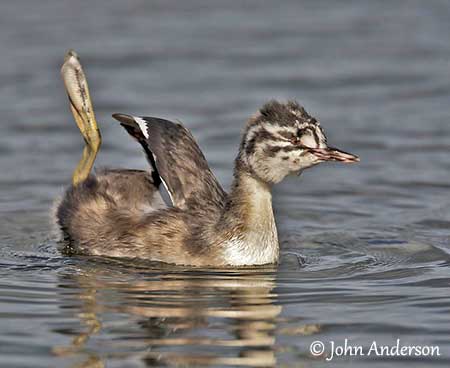
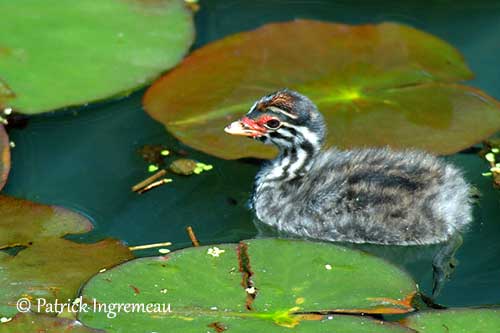
The grebes drop all their flight-feathers after breeding, and are flightless during 3-4 weeks. During this period, they gather at sites where they can find abundant food sources. The moult of the body feathers is completed during the first weeks of the winter.
However, the almost continuous moult of the flanks provides them a supply of feathers for their habit to swallow them in order to protect the digestive tract from sharp bones. They also give some feathers to the young. These feathers are then regurgitated as pellets.
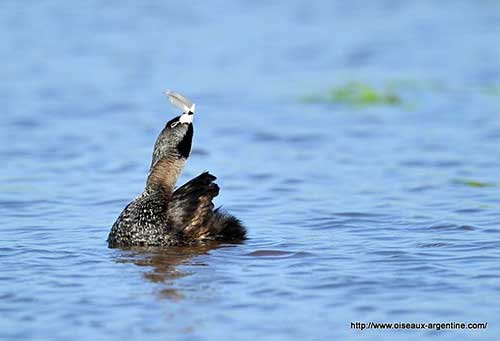
The grebes are strictly aquatic and frequent a wide variety of freshwater habitats, often large lakes and marshes. During the breeding season, they usually remain on freshwater shallow lakes or pools with large amount of floating vegetation, but also emergent and underwater plants. But some species such as the Western Grebe and the Great Grebe may breed along the coasts in sheltered bays. The smaller species, especially the Least Grebe, also breed on seasonal water bodies.
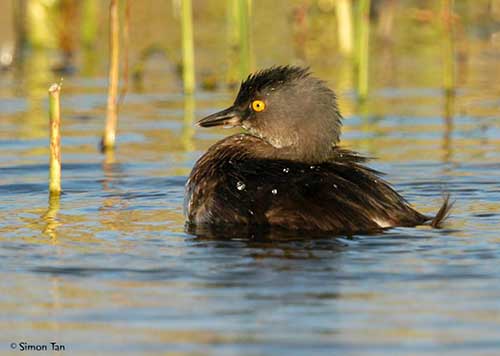
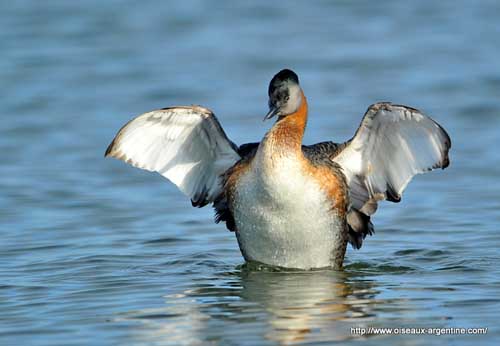
They generally stay far from snow and ice or cold waters, and avoid bare rock and gravel. But the Hooded Grebe is the exception in Patagonia where it breeds on lakes protected by rocky walls from the strong winds. Other species breeds on mountain lakes and can be found up to 4000 metres of elevation in the Neotropical Region.
Outside the breeding season, many species spend the winter in marine environment, other move to large inland lakes.
But two species, the Great Grebe and the Red-necked Grebe can be seen on the open sea in winter and relatively far from the coasts. On migration, they may occur on a variety of wetlands.
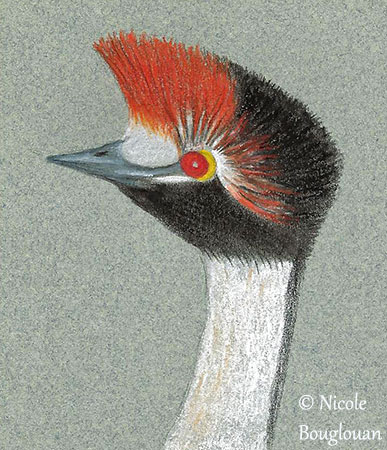
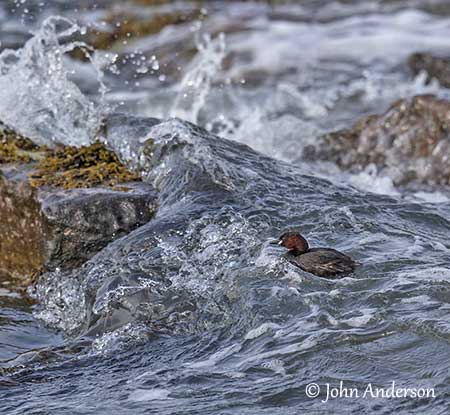
Their diet consists primarily of aquatic prey such as fish and arthropods. The species with elongated body, slender neck and long, thin bill are mostly piscivorous. However, the Horned Grebe which is a small, short-billed species is able to catch large fish because it is very agile when diving and pursuing the prey underwater. Food selection may be sometimes related to agility rather than bill size. The smaller grebes with short, rounded body, and fairly short neck and bill feed mainly on invertebrates.
The less piscivorous grebes consume other prey including a large variety of insects, molluscs (bivalves and univalves), snails, crustaceans (shrimps, crayfish and small others), amphibians (tadpoles and frogs) and some small fish. Some plant matter such as seaweeds, leaves, stems and seeds of aquatic plants are also part of the diet.
During the breeding season, they consume more insects and larvae and give them to their young.
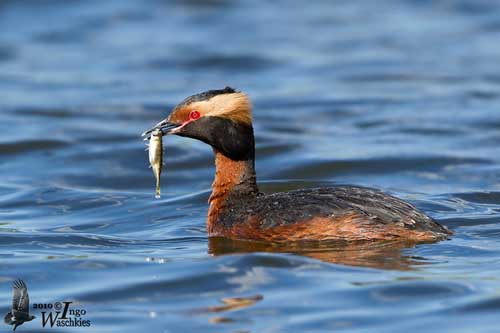
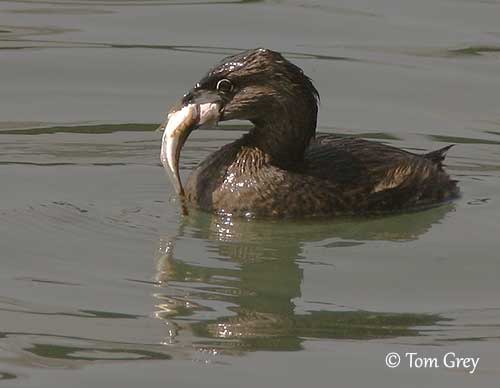
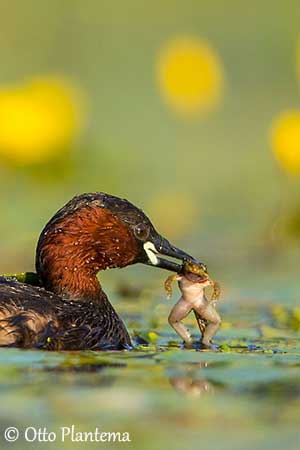
The vocal repertoire shows marked variations according to the species and the season. The voice of the Podicipedidae is described as barking, trilling, braying, whistling and wailing calls. These sounds can be heard during the courtship displays, but also in alarm or aggressive disputes.
The “advertising call” is given when a grebe is alone, and it stops only when the visual contact is restored with the mate or the chicks. This call plays a role in pair formation, and announces the species and the sex.
The grebes are silent outside the breeding season, but the members of genus Tachybaptus remain usually vocal.
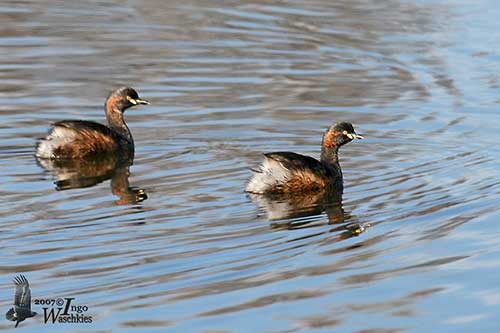
The grebes are seasonally monogamous.
The different phases of the breeding cycle are accompanied by various highly ritualized displays during which both male and female play an active role. The displays are performed on water surface and show the grebes swimming synchronously, rearing out of the water, or rushing wildly side by side across the water surface before diving simultaneously, or facing each other, breast to breast while shaking their heads or holding some weeds in their bills… All these displays are very spectacular and demonstrate the perfect synchronization achieved by both mates.
The “Rushing Ceremony” performed by the Western Grebe is one of the most spectacular display.
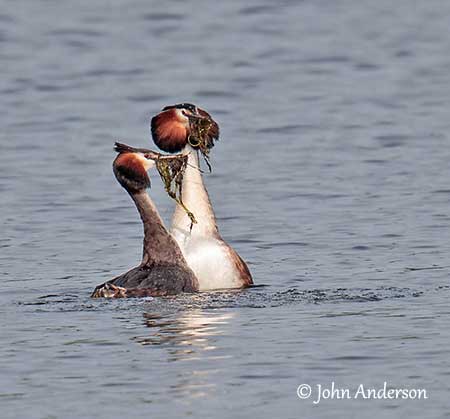
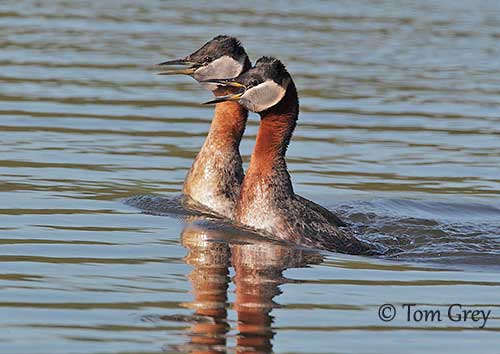
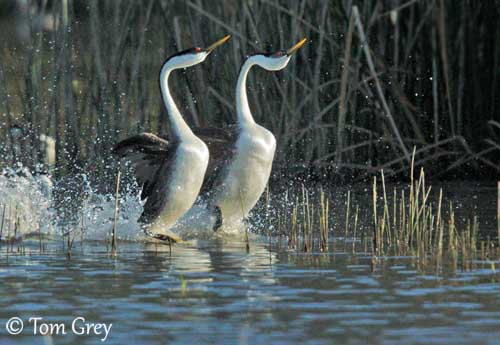
The copulation takes place out of the water, often on a platform specially built in shallow water by both male and female. One bird climbs onto the platform and invites the other. The first grebe is lying flat with the neck held forwards while uttering intermittent calls. The second grebe jumps onto the back of the other and copulates quickly before to return to the water by passing forwards over the head of its mate and calling during the process.
The sexual activity can start several weeks or months before the egg-laying. During this period, the grebes are territorial and perform defence displays, chases and even fights, and the male is usually more active than the female.
However, the colonial species are less aggressive and the defence behaviour is simplified.
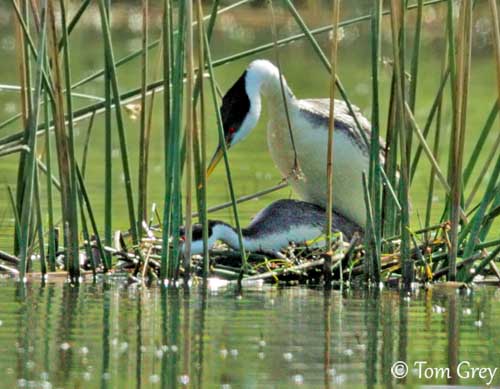
The nest is built by both mates, a partially floating platform anchored to the aquatic vegetation, or sometimes built up from the bottom. It is made with leaves and stems of aquatic plants and allows an easy access to and from the water. The nest site is usually in the shelter of a reedbed, although nests are occasionally placed in open water. Nest maintenance continues during laying and incubation, and some species may use the same nest for successive clutches.
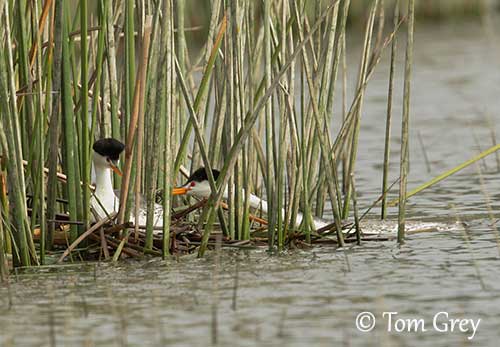
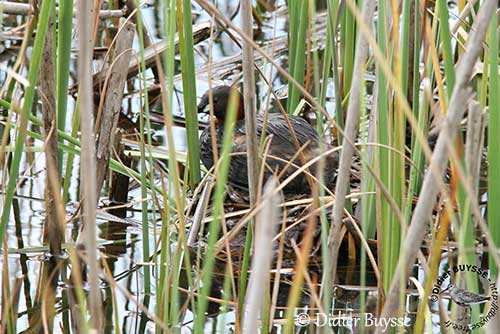
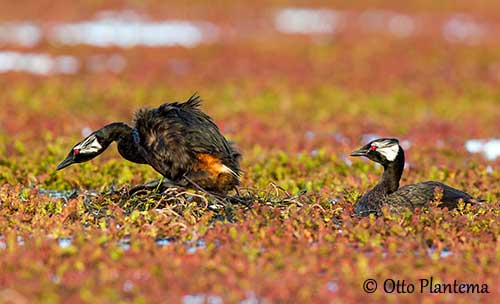
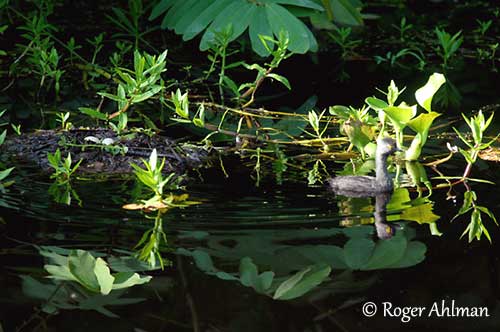
The usual clutch contains 2-7 white, creamy or pale blue eggs that quickly become stained brown. The incubation by both adults lasts from 20 to 30 days. The eggs are covered with nest material when the incubating adult leaves the nest.
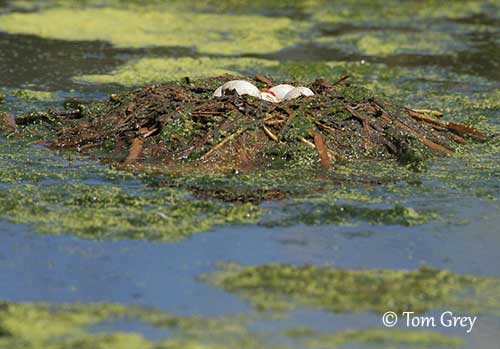
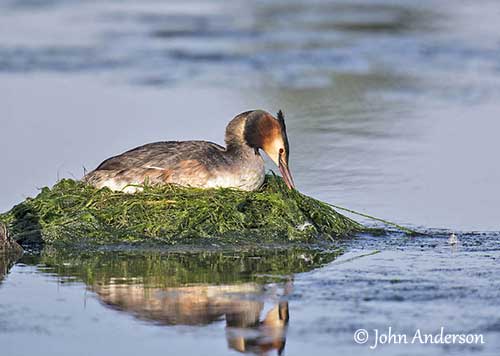
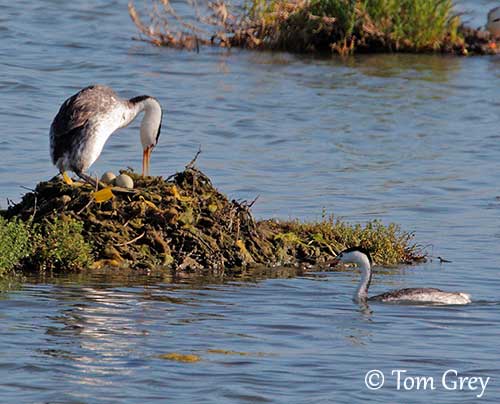
When the last egg has hatched, the adults desert the nest and carry their chicks on their backs, between the wings and the dorsal feathers. They can dive even with the chicks on their backs!
The chicks are precocial. They are able to dive if they need to hide themselves, remaining submerged with only the bill at the water surface. But they depend on parents for food and heat. The fledgling period varies from six to twelve weeks, depending on the species. The young grebe can breed at one or two years old.
A replacement clutch is laid after the loss of eggs or chicks.
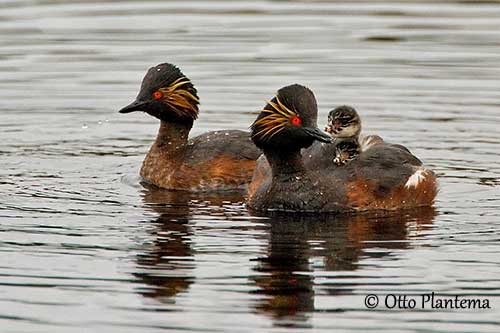
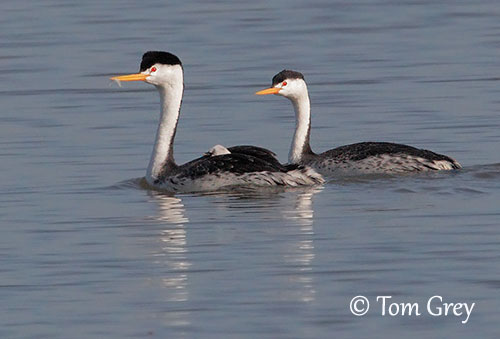
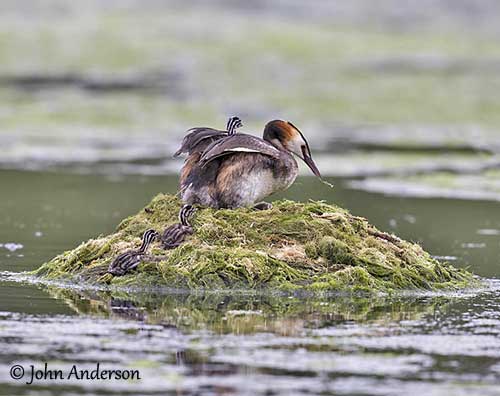
The female knows how to show gentleness and patience towards her young
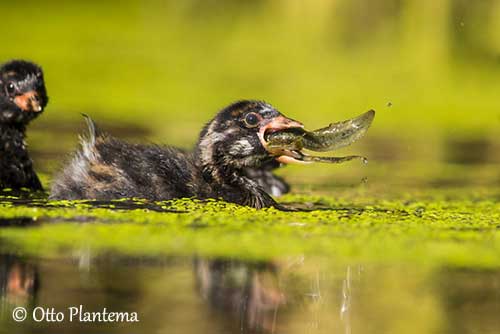
The main predators of the grebes at nest are birds such as gulls (Larus), crows (Corvus), harriers (Circus) and coots (Fulica). In some parts of America, raccoons can cause severe losses. Large fish such as introduced salmonids may also take the chicks.
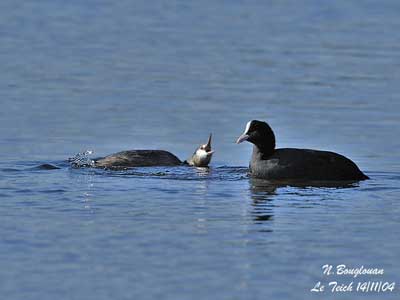
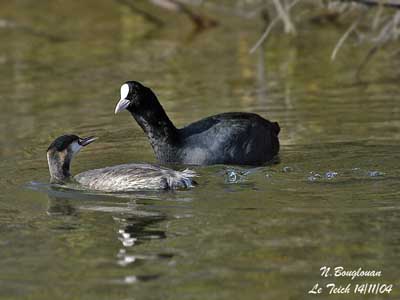
Great-crested Grebe and Common Coot
Intimidation display
Several species are dispersive or migratory, depending on the habitat. The grebes living at high elevations usually move or disperse, performing altitudinal movements after breeding. The movements are closely related to weather conditions and food resources.
On migration, the grebes fly overland by night, whereas during the day, they swim along the coast. The birds become more gregarious after breeding, and large concentrations on lakes are formed during the migrations and in winter. They are mainly diurnal, although in full moon nights, the activity continues after sunset.
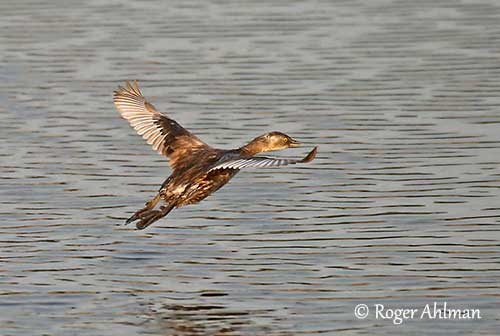
The grebes are widely distributed, but several of them are threatened.
Three species have gone extinct in the last half-century, the Atitlan Grebe, the Colombian Grebe and the Alaotra Grebe, probably due to habitat alteration, introduction of predatory fish and new fishing techniques.
On the other hand, the Junin Grebe and the Hooded Grebe are both Critically Endangered. They have small ranges and very small populations affected by the same problems.
The other species are not considered to be globally threatened, although some of them, especially the Titicaca Grebe, have restricted ranges. But several species have expanded in recent years, thanks to climate change because they are sensible to harsh winters, but also thanks to human activities increasing the number of ponds, gravel pits and reservoirs with no fluctuations of water levels, and growth of fish-farming.
However, other human activities have a negative impact, with the drainage of wetlands involving the destruction of the vegetation of the shores in which they nest. Pollution, pesticides, introduced predators and fishing-nets are important threats for all the species throughout the world.
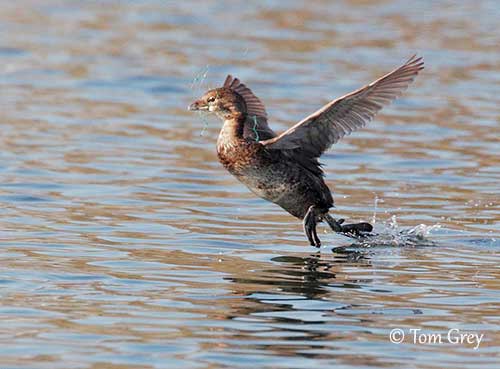
Photographer’s comment:
"I noticed that the bird was entangled in filament only when I processed the image; after posting it on a local birding site, I learned the bird had been seen earlier and had survived for months in this condition."
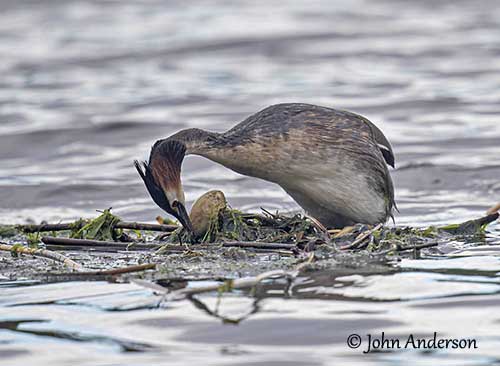
Grebes are magnificent birds and it would be a shame if they disappeared from the bodies of water in our world.
Conservation measures are underway everywhere to protect them and especially to preserve their habitat and their food sources.
Let’s take advantage of their presence on our lakes and wish them a safe and beautiful future!
